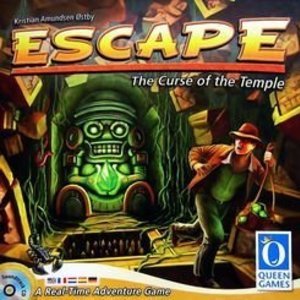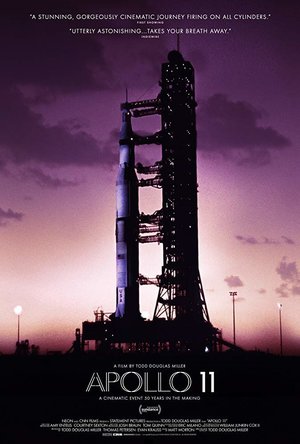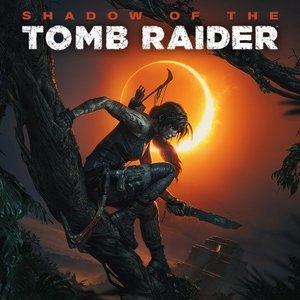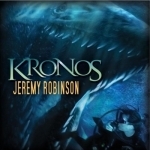Purple Phoenix Games (2266 KP) rated Escape: The Curse of the Temple in Tabletop Games
Jul 16, 2019 (Updated Dec 10, 2019)
Your latest quest has brought you and your comrades to an ancient temple. While exploring, you come across a treasure cache – score!! Your team decides to take it…for research purposes of course…but unbeknownst to you, this temple and its treasure are cursed, and you have just literally brought that curse down upon yourselves. The temple begins to collapse, and you and your team must make it to the exit alive! But wait, which way did you come from? Seriously? Did nobody leave any breadcrumbs? Which path is the right way? Too late to ask questions, just go! Traverse your way through this maze of a temple and get out! Will you make it out? Will your comrades make it too? I guess you’ll just have to wait and see…
DISCLAIMER: There are several expansions to this game, but we are not reviewing them at this time. Should we review them in the future we will either update this review or post a link to the new material here. -T
Escape: The Curse of the Temple is a real-time cooperative game in which players must roll dice, uncover new tiles, and find their way to the exit before the temple collapses, trapping the explorers inside. Played in exactly 10 minutes, all actions are taken simultaneously – you are trying to escape after all! By rolling dice, players can uncover new rooms and find magic gems. Once the exit tile has been discovered, all players must make their way to it and out of the temple! Strategy is key – do you move as a group in the same direction (there is safety in numbers…) or do you split up in an attempt to find the exit more quickly? That’s up to you and your team to decide – but decide quickly, because time is running out!
One super neat thing about this game is the countdown timer/soundtrack. When I say the game takes 10 minutes to play, I mean that literally – there is a timer! The corresponding soundtrack really brings the theme to life and creates a unique atmosphere. The pressure of a time limit means that players are frantically rolling dice and moving throughout the temple, just as they would be frantically searching for the exit in the real world. For a pretty simple game of dice-rolling, I think the timer adds to the overall excitement of the game – without it, there is no element of urgency and the theme would not feel as authentic.
That being said, timers kind of stress me out in games. One thing that can alleviate some of the pressure created by the timer is being able to work as a group. Cooperation is important to success because everyone wins or loses together. I don’t have to race against the clock on my own, I just need to do my part to help the group succeed. Whether it’s uncovering new room tiles or pooling dice with another player to find magic gems, winning Escape is, overall, a group effort.
If you’ve never played a real-time game or one with a timer before, I would recommend Escape: The Curse of the Temple. It’s simple enough to be a good introduction to the mechanics, yet engaging and exciting enough to keep you coming back. Purple Phoenix Games gives it a heart-pounding 17 / 24.
Kirk Bage (1775 KP) rated Apollo 11 (2019) in Movies
Jan 22, 2021
Director Todd Douglas Miller makes the bold choice to do away with all narrative, cutaway interviews and commentaries, and just shows you what happened in gorgeous detail, with a kind of retro super 8 camera vibe, and a very evocative sountrack. The degree of unseen footage of the entire project is jaw-dropping, especially if there is something of a science or even science fiction geek within you.
Some of what you see and hear is, of course, so iconic that when you see or hear them you feel a sense of deja vu that feels like a dream in the context of the full story. The rest is so amazing to contemplate as something that humanity actually achieved that it is tempting to see it as an odd retro sci-fi movie with quite bad effects and a dull plot; the control room, suits, the rocket itself, the sense of endless patience, anticipation and waiting – you just wouldn’t believe it would work if it was a fiction.
At several points I found myself reminding myself that it wasn’t a fiction, and then marvelling at the entire world that existed at the end of the 60s, and how so essentially different it was, and how ancient it feels now. I wasn’t quite born when all this happened, but it has been very much in my imagination all my life. I wanted to be an astronaut, as did most other kids in the Star Wars era of the late 70s and early 80s, and I only really gave up when I realised that meant being as smart and dedicated as Neil Armstrong and not as reckless and cool as Han Solo. Now I am older, I can appreciate things about it that I never could, and in understanding Human history, it is a riveting chapter.
What we see in this film is how detail and hard work and maths and safety precautions and thousands of team members made this happen. Every nut and bolt, and every drop of sweat and fuel is counted, recounted and considered. At times it seems mundane and without drama, boring even, and then the sheer scale of acheivement and wonder overtakes you as you catch yourself realising how incredible it was that any of this was done at all.
There is no political overtone or background here, no conspiracy theory, no other voice questioning the economic impact or wisdom of the entire endeavour, just a childlike but serious minded wonder at doing something because we could if we set our minds to it. And for that it has a beauty and transcendent elegance that rarely accompanies the subject. By the end, there is really only one word to describe the fact that over 50 years ago three men looked down on the Earthrise and beheld every other living thing in existence in one glance. And that word is: wow!
It is slow, for sure, but only because we have become used to pace and forced drama, from our fictions and our documentaries. Apollo 11 won’t be for everyone in that case, and may even be fairly called dull by some who can’t relate to it in any way. For me it was a trance like epiphany I can’t forget. Highly recommended if you are looking for something fascinating, educational and thought provoking out of your comfort zone and out of this world!
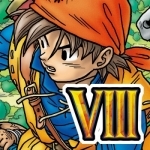
DRAGON QUEST VIII
Games
App
[Recommended Hardware] iPhone 5 or Higher/iPad (3rd Generation or Better) Please Note: iPhone 4 is...
Gareth von Kallenbach (980 KP) rated the PC version of Shadow Of The Tomb Raider in Video Games
Aug 14, 2019
Shadow of the Tomb Raider is the third installment in the reboot of the franchise. Lara is no longer a naïve, explorer in training, who struggles with the idea, much less the actual action, of killing a human being. The years have made her a more seasoned (and possibly more ruthless) tomb raider, and she has now blossomed into the badass character that she is known for. Her adventures will take her deep into Mexico and South America, where she is trying to stop the apocalypse that she had accidently set in motion when she acquired an ancient dagger. What follows is roughly a 12+ hour main story and several hours’ worth of side missions that help flesh out the story and the world around her. The best part is that the story has all the excitement and thrills you would get if you took an Indiana Jones movie and added some of the Mel Gibson drama Apocalypto, so buckle up and enjoy the ride.
Shadow of the Tomb Raider adds the social interaction that was largely missing in the previous installments. While there are still plenty of times when Lara will be out on her own, searching through ruins or trekking through the jungle, there are now several civilizations that Lara will be interacting with. Her adventures will take her to the ancient city of Paititi, where most of her interactions will be with the locals and the main antagonists to the trilogy, Trinity. It’s in the interactions where we really get to see Lara question not only her beliefs but also her actions when acquiring ancient artifacts. Many of the discussions revolve around what will happen if outsiders come and try to change their standard of living or force their own wills on the natives. These discussions cause Lara to reevaluate what she does for a living, and how her own actions have an impact far greater than she even realizes. The inclusion of so much interaction with other people brings a whole new dimension to the Tomb Raider world and it entrenches you in the story in a way that battling even the most dangerous tombs never could.
One of the most interesting levels in the game takes you back in time to when Lara was just a young girl. You get the opportunity to experience the world through the innocence of a child, and her own imagination as she explores her father’s mansion. It provides an interesting look into the events that would unfold during her impressionable years, and also helps to offer some additional insight into what drives her as an adult. It’s in this level, where you finally understand what fuels her desire and continues to push her forward.
Gameplay is largely the same as the previous titles, but they did add a few new interesting ways to traverse some of the more difficult terrain, such as the ability to rappel down cliffs or using a pick axe to traverse cave ceilings. Climbing, jumping and swinging are all handled very intuitively using the controller. Yes, there were times where I felt I was doing the right thing and fell to my death anyway, but at no time did I feel overly frustrated or blame the tight controls for my own missteps.
Swimming and diving play a far bigger role in Shadow than in the previous games. Long, deep caverns will require you to swim and find pockets of air to keep from drowning. There are even a few sequences where you will need to swim through plants to avoid the various eels and piranha that will kill you, and swimming through the plants is just as easy as it sounds. Thankfully I never felt these sequences played on for too long and they certainly added diversity to the levels. While generally swimming and diving in video games tend to be an exercise in frustration, I never felt that was the case here.
Stealth also plays a bigger role in this game and adds another key to your survival. The original 1996 game focused on your dual pistol wielding abilities to get you out of jams and in this game, you are rewarded with a subtler approach. Taking a nod from games such as Horizon Zero Dawn, you will now have plenty of opportunities for Lara to crouch in large grassy fields or cover herself in mud and hide amongst the vines and cliff walls to surprise and take down her enemies. You can now overcome many adversities utilizing only stealth, but don’t worry, if you prefer more upfront action, there are still the obligatory pistols, shotguns and machine guns you can use to dispatch foes. Stealth is just an added way to ensure that Lara saves her bullets for far bigger threats down the road.
Now for everyone’s favorite part…the tombs! What would Tomb Raider be without tombs and the challenges that come along with them? As you may have already guessed, all sorts of puzzles and booby traps await you on your journey. I found they kept a nice balance between challenging and entertaining and thankfully none of them were so obscure that you need to break out Google to overcome them. Another great addition to the game is that the player can now individually adjust the difficulty on puzzles and on combat. That means if you love combat but not the puzzles you can adjust them independently, which is something I wish far more games would take advantage of. Either way, there are plenty of challenging tombs where you can flex your tomb raiding muscles.
As your adventure progresses you will earn skill points that allow you to upgrade Lara with new abilities. There are three skill trees, each containing many different skills, where Lara can spend her points. The three trees are broken down into Seeker, Warrior and Scavenger and Lara can be upgraded when she arrives at a basecamp. A few of these upgraded skills are longer swim times, multiple stealth takedowns, and the ability to shoot two enemies simultaneously. It’s always exciting to upgrade your character and see how the gameplay changes with new your abilities. This game is no exception and the upgrades you choose can really enhance your experience.
Graphically, Lara has never looked better. I played the game on my Xbox One X in 4K and the environments were awe inspiring. The lush jungle almost jumps off the screen and the character models are some of the best I’ve seen in recent memory. Of course, all this beauty wouldn’t mean much if there were stutters and lags and thankfully I never noticed a single frame drop while playing the game in all its 4K glory. Shadow of the Tomb Raider feels like you are part of a high budget, summer blockbuster and at times it was difficult to determine the difference between a cutscene or live game play (in a “wow, this is incredible!” way). The acting was also top notch and Camilla Luddington once again does an outstanding job delivering her lines, even making some of the corniest statements endearing. Every aspect of this game is the best of the best and you will be hard pressed to find an area of the game that was lacking.
Shadow of the Tomb Raider in an amazing accomplishment and easily my favorite game of the series. I’d even go as far as saying that I enjoyed it more than Uncharted 2, which is a true testament to how much I loved this game. Not only does the story have a heart and completely engages the player but it’s thrilling and there is non-stop adventure until the very end. While this certainly could be the last game in the rebooted series, I truly hope it’s not as I already want to play another. I highly recommend picking this game up. As soon as you knock over your first pot, you will be happy that you did!
What I liked: Stunning graphics, Incredible voice acting, Blockbuster feel
What I liked less: Occasional areas where it was unclear where to go next
Rachel King (13 KP) rated A Short History of Myth in Books
Feb 11, 2019
In seven chapters, Armstrong takes a simplified stroll through history, focusing on the concept of myth and its impact on civilization. All throughout the book, she attempts to support her claim that a person can believe in myths without believing that the myths are actually true, and that the failure of modern society is by not following her specific edict. While this notion strikes me as absurd, I keep reading because, hey, it's a short book.
While I know only bits and pieces about many of the world's religions, I do know both the history and the holy book of my religion, Christianity. It becomes apparent to me early in the text that she is masking her opinions and interpretations of this religion as actual fact, so I can only imagine how she misconstrues other religions.
Her citations were lacking to me, with many claims going unsupported, others only partially supported, such as citation #84 and #30, and some citations simply not even applying to the specified text, such as citation #87. In citation #55, she claims that the Bible contains a Creation myth in which God brings the world into being by killing a sea monster, but one of the four verses she cites make no reference to anything of the sort (Job 3:12), and the other three (Isaiah 27:1, Job 26:13, Psalm 74:14) that do mention a leviathan cannot be interpreted that way when read in context. Isaiah is describing the end of days, while Job merely says that God created the serpent, and the verse in Psalm is within the context of a song about God rescuing the Hebrews from Egyptian slavery -- no relevancy to Creation. She makes the claim that Paul "was not much interested in Jesus's teachings, which he rarely quotes, or in the events of his earthly life." This claim is easily disproved by examining how Paul's words line up with Jesus's in John 5:21 vs. 1 Corinthians 15:22, Matthew 6:25 vs. Philippians 4:6, and many other passages.
While going through the citations, I got the feeling that the author depended on secondary sources for her information without actually studying the original source of her information. The book struck me as highly opinionated, vague, and too general for the topic being addressed. I have no doubt that there are better and more thorough books available on the topic of myth. I do not believe that I will be reading any more of Armstrong's works in the future.

Nelly Cootalot: The Fowl Fleet
Games, Entertainment and Stickers
App
Best of Mac App Store 2016 game now on iOS! "The funniest mobile game of 2017 if not all time." -...

Tai Chi 24 & 48 Simplified Form
Health & Fitness and Lifestyle
App
Learn the most popular forms of Tai Chi in the world from a Grandmaster. • 2.5 hours of streaming...
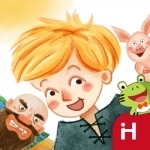
iHuman Books
Education and Book
App
We help kids fall in love with reading! iHuman Books presents a full package of engaging reading...
